With their majestic appearance and compact size, the Lhasa Apso is a breed that effortlessly combines regality with charm. Originating from Tibet, these dogs were once revered as guardians of palaces and monasteries, a role that has bestowed them with an air of nobility.
But there is much more to the Lhasa Apso than their captivating presence. From their unique coat to their adaptable nature, this breed offers a fascinating blend of characteristics that make them a compelling choice for dog enthusiasts.
So, what sets the Lhasa Apso apart from other breeds? Let's explore their history, size, temperament, and more to uncover the true essence of this captivating companion.
Key Takeaways
- Lhasa Apsos are a small breed of dog that originated in Tibet and were used as watchdogs in palaces and monasteries.
- They are well-suited for apartment living, with low exercise needs and the ability to adapt to small spaces.
- Lhasa Apsos have a long, double coat that requires regular grooming and professional grooming to maintain.
- While generally healthy, they are prone to certain health conditions such as eye problems, allergies, and hip dysplasia.
Origin and History
The Lhasa Apso breed has a rich history that traces back to Tibet, where they were exclusively bred by nobility and monks. Known as Abso Seng Kye in Tibet, these dogs were considered sacred and a symbol of good luck. Their small stature and compact, sturdy build made them well-suited for their role as watchdogs in palaces and monasteries.
In 1933, they were first introduced to the United States, where they gained popularity as companion animals. Standing 10 to 11 inches high for males and slightly smaller for females, Lhasa Apsos have an average weight of 13 to 15 pounds.
With their origins deeply rooted in Tibetan history, this breed holds a special place in the hearts of dog enthusiasts around the world.
Size and Weight
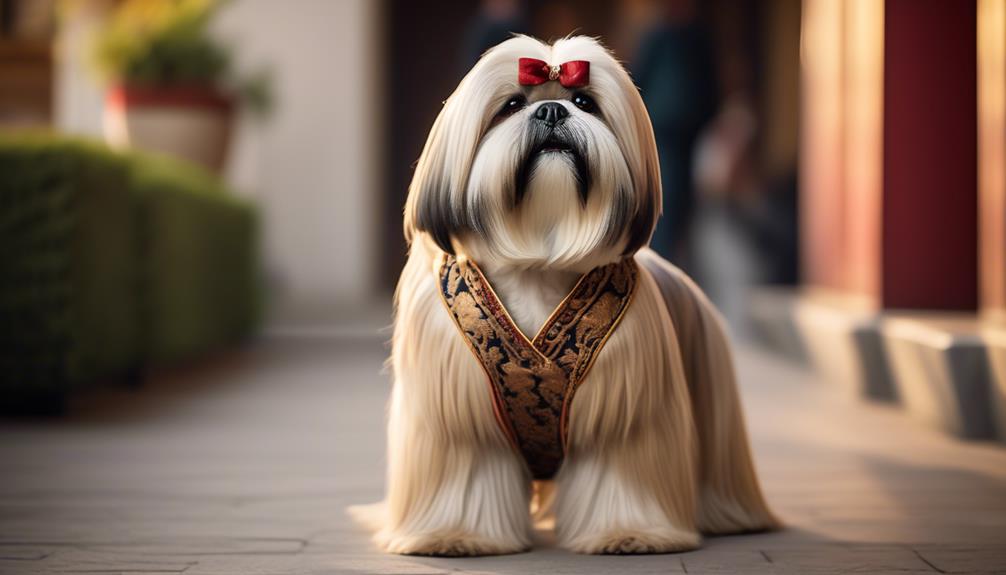
With an average weight of 13 to 15 pounds, the Lhasa Apso is a small breed known for its compact and sturdy build. Despite their small size, they possess a strong and robust physique. Here are some key characteristics of the Lhasa Apso's size and weight:
- Height: Males typically stand 10 to 11 inches tall, while females are slightly smaller.
- Weight: The average weight of Lhasa Apsos ranges from 13 to 15 pounds.
- Compact Build: Lhasa Apsos have a well-proportioned body, with a solid and muscular frame.
- Sturdiness: Despite their small stature, Lhasa Apsos are known for their strength and endurance.
These physical attributes make the Lhasa Apso an ideal companion for individuals or families seeking a small, yet sturdy and resilient dog breed.
Breed Group Classification
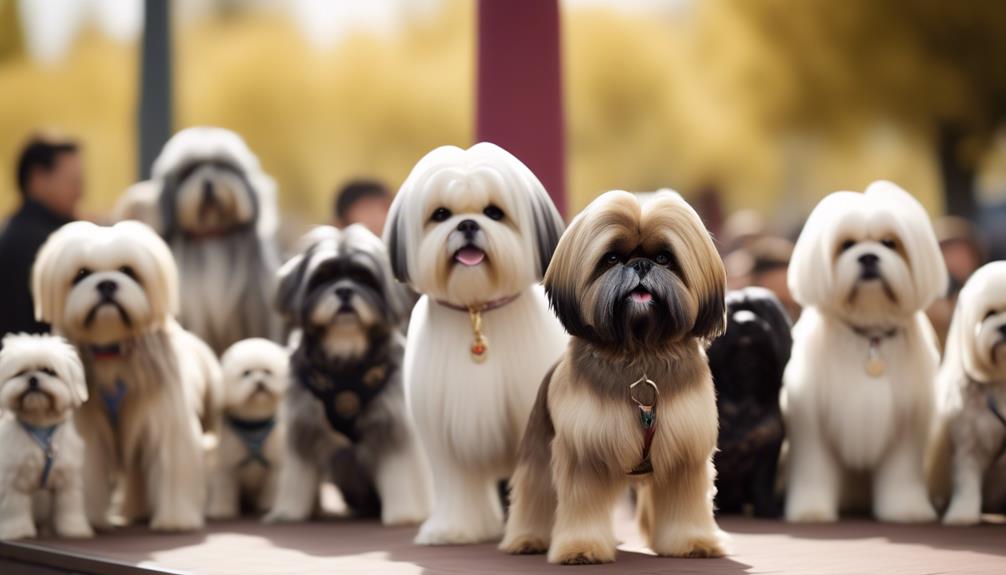
Classified as a non-sporting breed, the Lhasa Apso is known for its distinct characteristics and heritage. This breed belongs to the non-sporting group, which includes a diverse range of breeds that don't fit into other specific categories.
Non-sporting dogs are known for their versatility and adaptability to various living situations. The Lhasa Apso's classification as a non-sporting breed reflects its role as a companion dog rather than a working or sporting dog.
With their regal appearance and dignified demeanor, Lhasa Apsos make excellent family pets and are well-suited for apartment living. They're intelligent, independent, and have a strong sense of loyalty.
Despite their small size, they possess a keen watchdog instinct and are known for their alertness and protective nature.
Lifespan
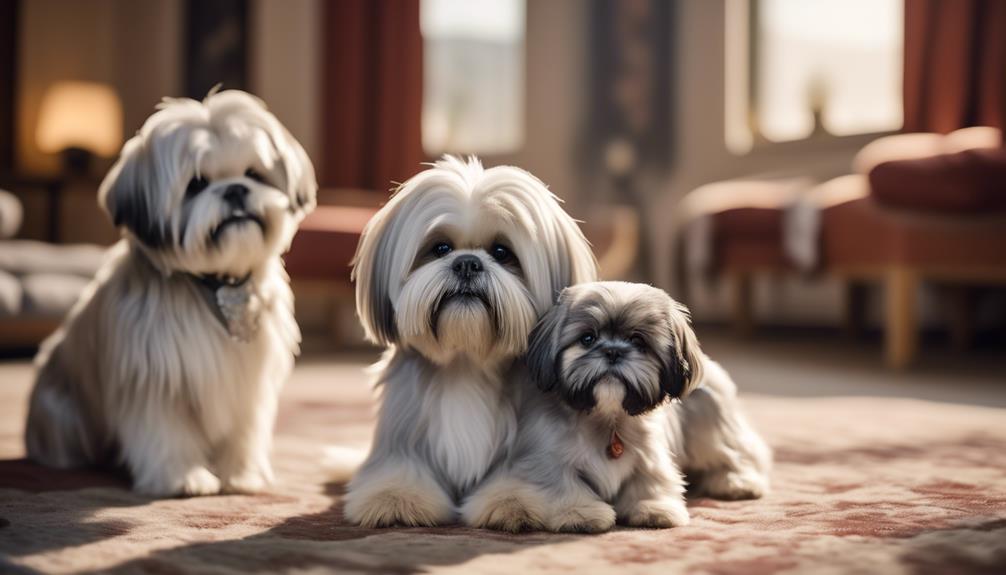
The Lhasa Apso has a lifespan of 12-18 years, making it a relatively long-lived breed. This breed's longevity can be attributed to various factors, including its overall good health and genetic makeup.
Here are four key factors that contribute to the Lhasa Apso's lifespan:
- Genetic predisposition: The Lhasa Apso is known for being a healthy breed, with fewer hereditary health issues compared to other breeds. This genetic resilience helps them live longer lives.
- Proper nutrition: Providing a balanced and nutritious diet is crucial for the Lhasa Apso's overall health and wellbeing. This breed requires a high-quality diet to support its longevity.
- Regular exercise: Engaging in regular physical activity helps maintain the Lhasa Apso's muscle tone, joint health, and overall vitality. Daily exercise routines contribute to their extended lifespan.
- Veterinary care: Regular check-ups, vaccinations, and preventive care are essential for detecting and treating any potential health issues early on. Proper veterinary care ensures the Lhasa Apso's well-being and promotes a longer lifespan.
Coat Characteristics
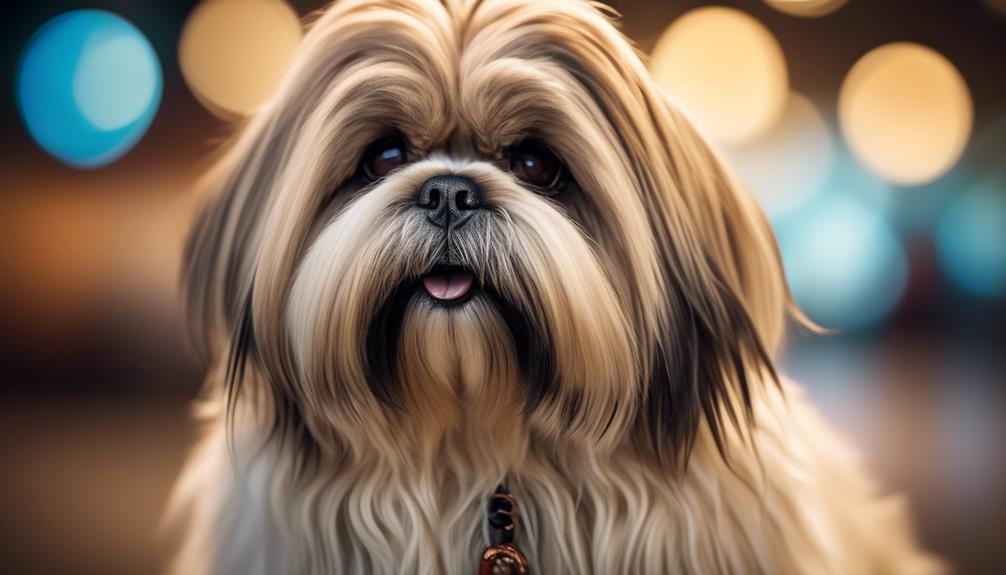
The Lhasa Apso's dense and luxurious coat is one of its most distinctive and prized characteristics. This breed has a long, double coat that comes in a variety of colors, including gold, cream, black, and gray. The outer coat is straight and heavy, while the undercoat is soft and wooly.
The Lhasa Apso's coat isn't only beautiful, but also serves a practical purpose. It provides insulation and protection from the harsh weather conditions of its native Tibet. However, this luxurious coat requires regular grooming to prevent matting and tangles. Daily brushing is recommended to keep the coat healthy and free of debris. Occasional trimming and professional grooming may also be necessary to maintain its appearance.
Adaptability to Apartment Living
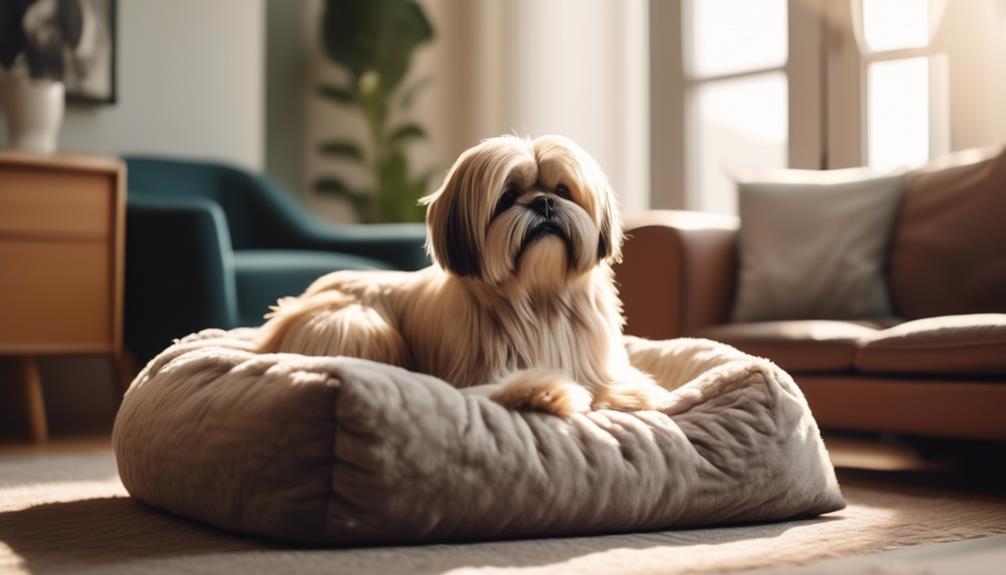
Living in an apartment, the Lhasa Apso dog breed demonstrates excellent adaptability. Despite their small size, Lhasa Apsos can thrive in smaller living spaces. Here are a few reasons why they're well-suited for apartment living:
- Low exercise needs: Lhasa Apsos don't require extensive exercise and are happy with short walks or play sessions.
- Intelligent but stubborn: While they're intelligent, Lhasa Apsos can be stubborn at times. However, with consistent training, they can quickly learn to adapt to apartment rules.
- High-maintenance grooming: With their long, double coats, Lhasa Apsos require regular brushing and occasional professional grooming. However, their grooming needs can be managed in an apartment setting.
- Generally healthy: Lhasa Apsos are generally healthy, which means they're less likely to require frequent visits to the vet, making them a suitable choice for apartment living.
Exercise Needs
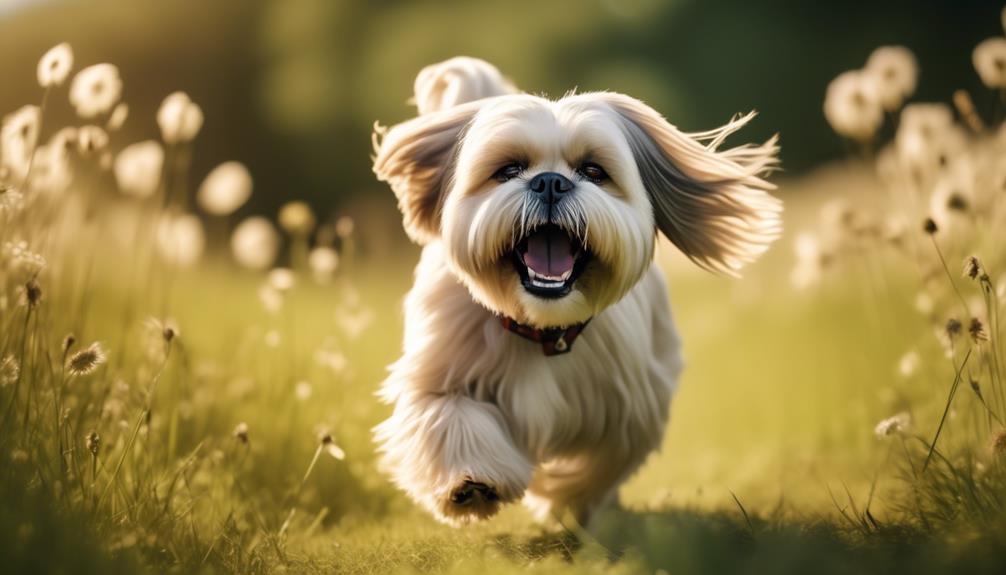
Lhasa Apso dog breed has moderate exercise needs that can be easily met in an apartment setting. They enjoy short walks and play sessions to keep them mentally and physically stimulated. While they are not high-energy dogs, they still require regular exercise to prevent weight gain and maintain overall health. A 3-column and 3-row table can be used to provide a visual representation of their exercise needs:
| Exercise Needs | Frequency | Duration |
|---|---|---|
| Short Walks | Daily | 20-30 mins |
| Play Sessions | Several times a day | 10-15 mins |
| Mental Stimulation | Daily | 10-15 mins |
These exercise activities can be easily incorporated into their daily routine, making them suitable for apartment living. It is important to note that Lhasa Apsos may have a tendency to be stubborn, so consistent training and mental stimulation are key to keeping them engaged and satisfied.
Training Requirements
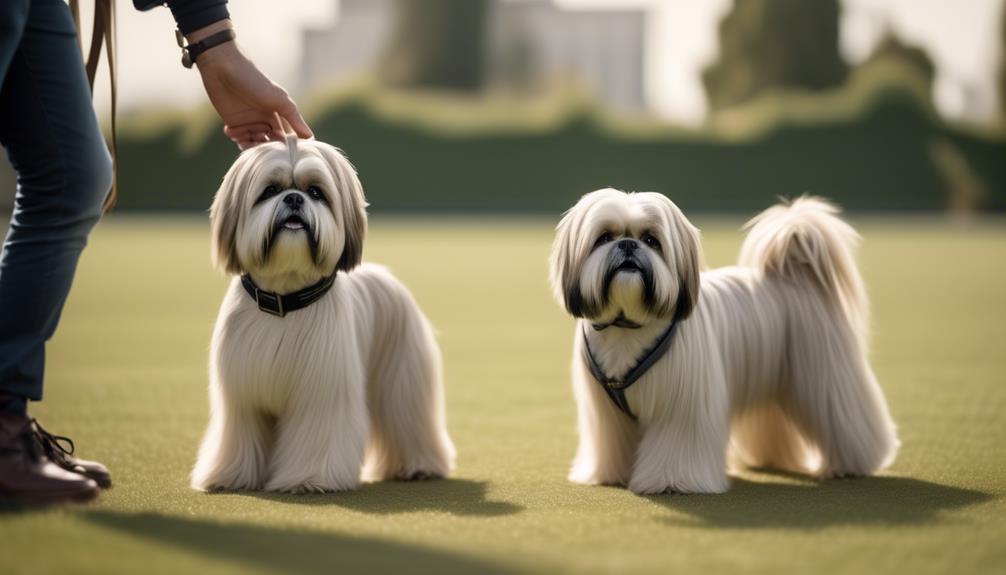
Training requirements for the Lhasa Apso breed include consistent and patient training methods to ensure their obedience and well-behaved nature. Lhasa Apsos are intelligent but can be stubborn, so it's important to establish clear boundaries and enforce rules from a young age.
Here are four key factors to consider when training a Lhasa Apso:
- Positive reinforcement: Lhasa Apsos respond well to positive reinforcement techniques such as praise, treats, and play. Rewarding good behavior will encourage them to repeat it.
- Socialization: Early socialization is crucial to prevent shyness or aggression. Expose them to a variety of people, animals, and environments to help them become well-rounded and confident.
- Consistency: Lhasa Apsos thrive on routine and consistency. Establish a consistent training schedule and use the same commands and cues to reinforce their training.
- Patience: Lhasa Apsos mature slowly, so patience is key. Avoid getting frustrated and be patient when teaching them new commands or behaviors. With time and consistency, they'll learn and respond well to training.
Grooming Demands
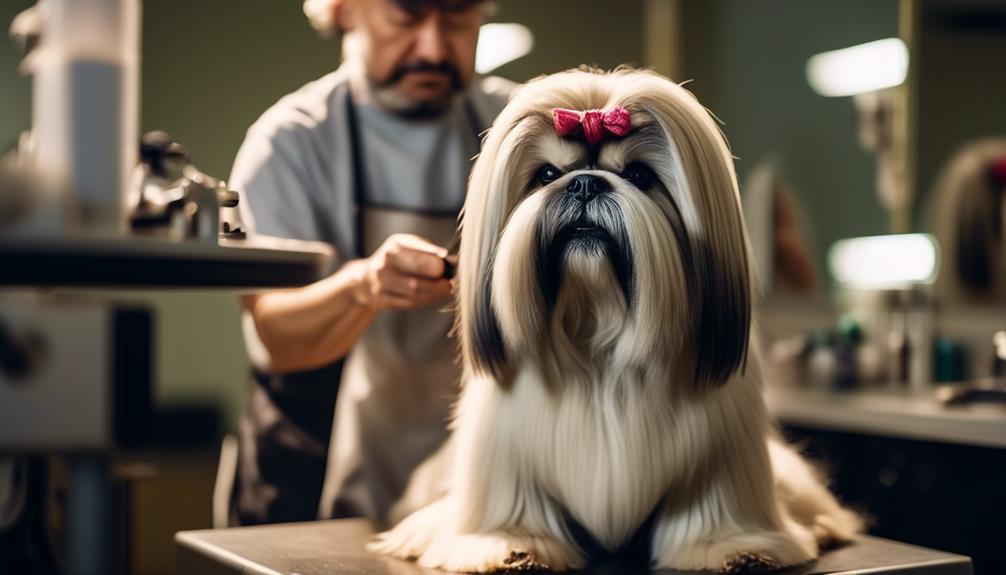
Regular grooming is essential for the Lhasa Apso breed to maintain their long, double coat in optimal condition. These dogs have a high-maintenance grooming routine that includes regular brushing and occasional trimming. Many Lhasa Apso owners opt for professional grooming to ensure that their dog's coat stays healthy and tangle-free. The table below provides a visual representation of the Lhasa Apso's grooming demands:
| Grooming Demands | |
|---|---|
| Regular brushing | Occasional trimming |
| Professional grooming | Helps maintain coat health and prevent tangles |
| Benefits of regular grooming: | |
| Keeps the coat clean and free from debris | |
| Reduces shedding and hair matting | |
| Promotes healthy skin and coat | |
| Prevents the development of skin irritations and infections |
Common Health Issues
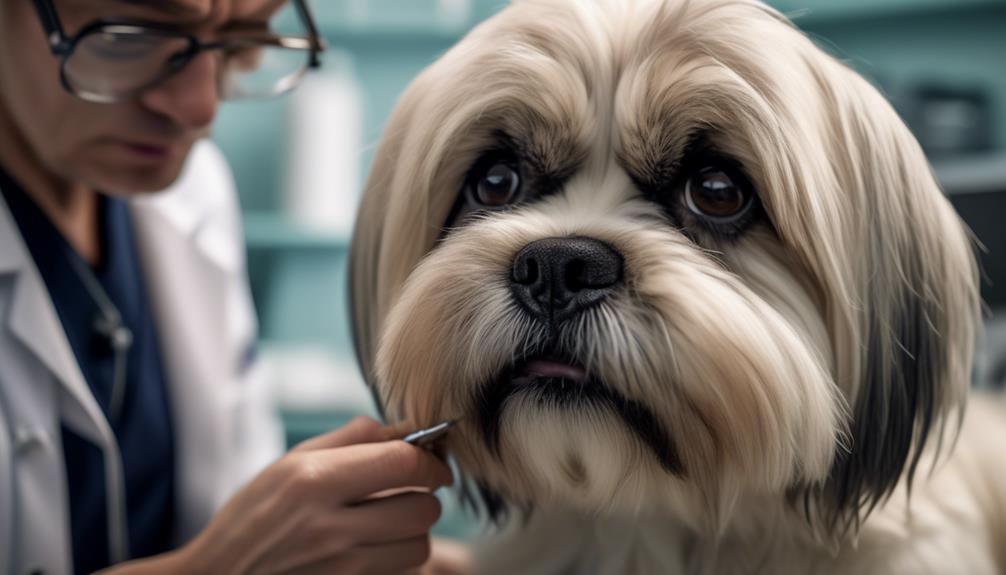
Moving on to the topic of health, it's important to be aware of the common health issues that can affect the Lhasa Apso breed. Some of the common health issues that Lhasa Apsos may face include:
- Eye Problems: Lhasa Apsos are prone to various eye problems, such as cataracts, progressive retinal atrophy (PRA), and dry eye (keratoconjunctivitis sicca).
- Allergies: Like many other breeds, Lhasa Apsos can suffer from allergies, which can manifest as skin irritations, itching, and respiratory problems.
- Hip Dysplasia: This is a genetic condition that affects the hip joint and can cause pain, lameness, and difficulty in walking.
- Patellar Luxation: Lhasa Apsos may also be prone to patellar luxation, a condition where the kneecap slips out of place.
Regular veterinary check-ups and proper care can help in managing these health issues and ensuring the well-being of the Lhasa Apso breed.
Considerations for Apartment Living
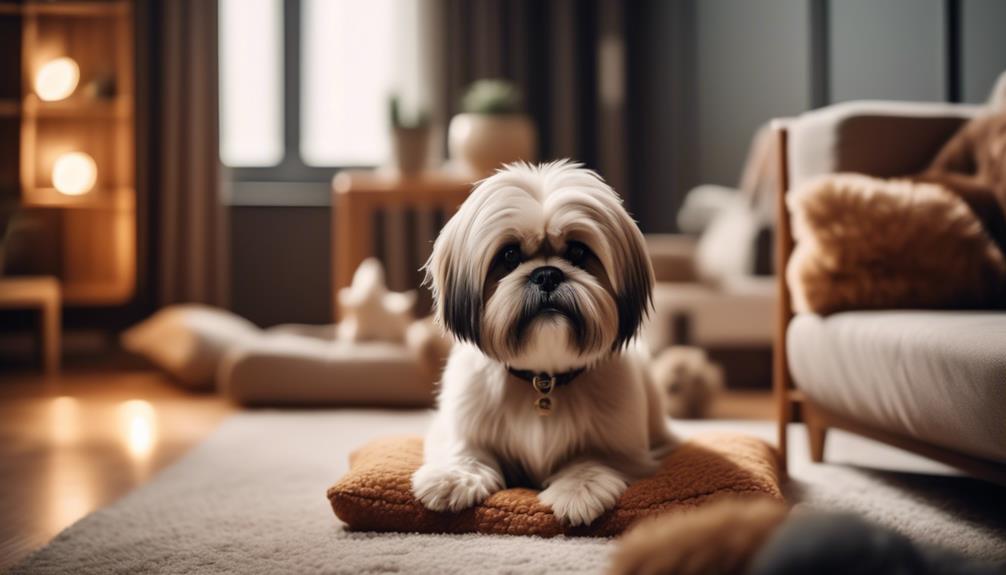
When living in an apartment, the Lhasa Apso breed offers adaptability and suitability due to its low exercise needs and ability to adapt well to apartment living.
Lhasa Apsos are small dogs, standing 9-11 inches tall and weighing 12-18 pounds. They have a non-sporting breed group classification and a lifespan of 12-18 years. This breed is known for its long, double coat and comes in various colors.
Lhasa Apsos are intelligent but may be stubborn, so consistent training is necessary. They require high-maintenance grooming, including regular brushing and professional grooming.
While generally healthy, they are prone to eye problems, allergies, and hip dysplasia.
Behavior and Temperament

How does the behavior and temperament of Lhasa Apsos contribute to their suitability for apartment living?
Lhasa Apsos possess certain behavioral traits and temperament that make them well-suited for apartment living. Here are four key factors that contribute to their suitability:
- Low exercise needs: Lhasa Apsos don't require extensive exercise and are content with short walks or play sessions. This makes them ideal for apartment dwellers who may not have access to large outdoor spaces.
- Minimal barking tendency: While they've a tendency to bark or howl, Lhasa Apsos can be trained to minimize excessive barking. This is crucial in maintaining a peaceful living environment in close proximity to neighbors.
- Low wanderlust potential: Lhasa Apsos are generally known to have low wanderlust potential, meaning they're less likely to try to escape or roam outside of their designated living area.
- Potential for playfulness: Despite their small size, Lhasa Apsos have a playful disposition, which can be a delightful source of entertainment for apartment dwellers without the need for extensive exercise options.
Introduction to Lhasa Apso History
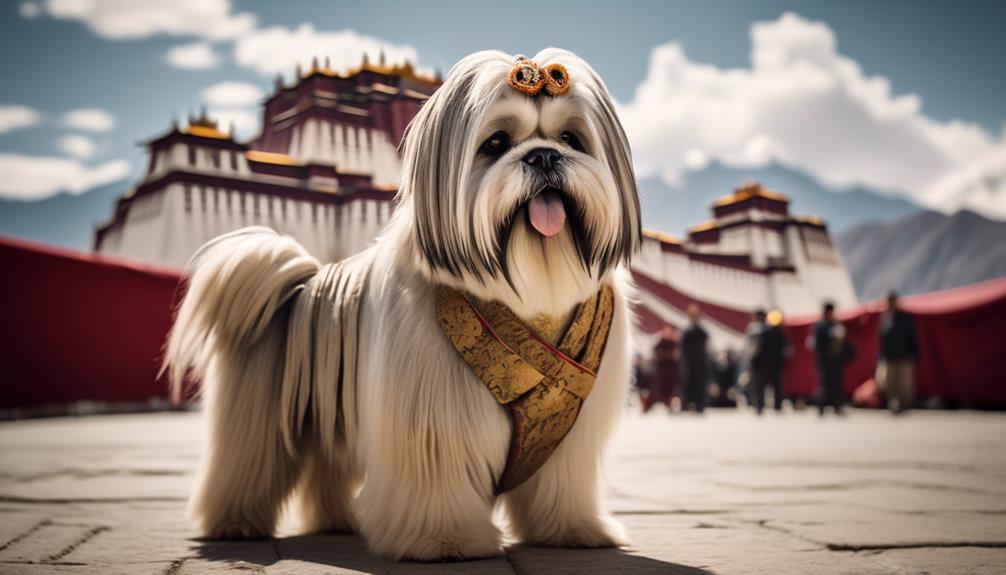
The history of the Lhasa Apso can be traced back to its origins in Tibet, where it was exclusively bred by nobility and monks. Known as Abso Seng Kye in Tibet, the Lhasa Apso was considered sacred and a symbol of good luck. This small breed was highly valued for its guarding abilities and was kept in palaces and monasteries.
In 1933, the Lhasa Apso was first introduced to the United States, where it gained popularity as a companion dog. Despite its small size, the Lhasa Apso has a compact and sturdy build. Males stand 10 to 11 inches high, while females are slightly smaller. On average, the Lhasa Apso weighs between 13 to 15 pounds.
Lhasa Apso Size and Build
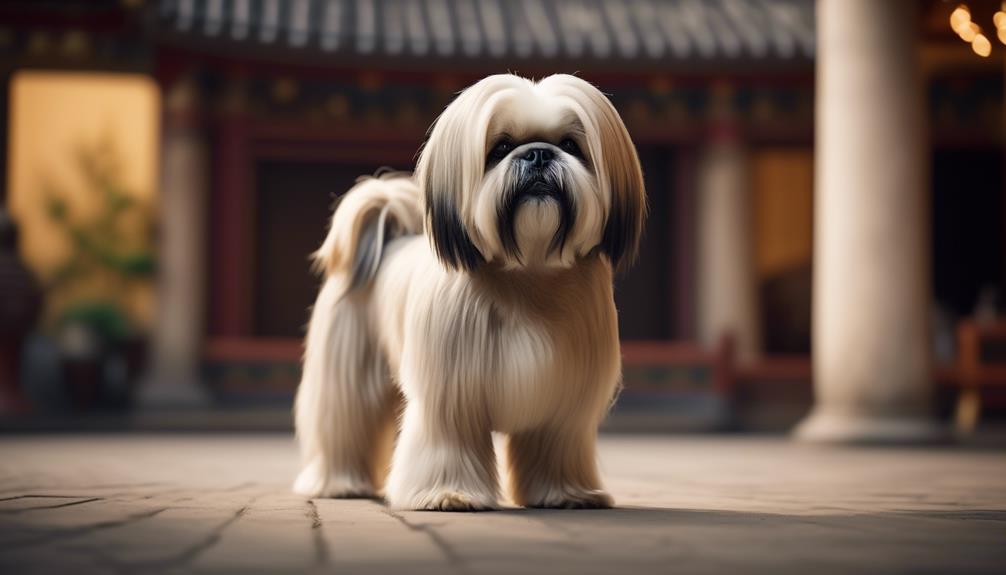
After exploring the history of the Lhasa Apso, it's important to understand the size and build of this compact and sturdy breed. Here are some key characteristics of the Lhasa Apso's size and build:
- Height: Males stand 10 to 11 inches high, while females are slightly smaller.
- Weight: On average, Lhasa Apsos weigh between 13 to 15 pounds.
- Compact Build: Despite their small size, Lhasa Apsos have a sturdy build.
- Well-Proportioned: They've a balanced body with a level topline and a tail that curls over the back.
These physical attributes make the Lhasa Apso an ideal companion for those looking for a small yet robust dog. Their compact build allows them to navigate various environments with ease while maintaining their agility and strength.
Health Care and Grooming Recommendations
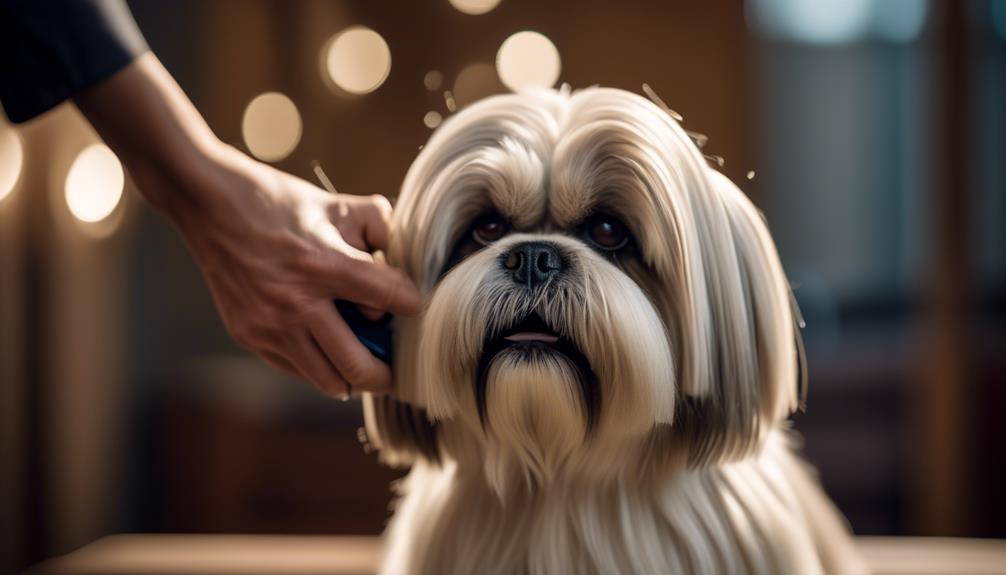
Regular grooming and proper healthcare are essential for maintaining the health and well-being of a Lhasa Apso. This breed has a long, double coat that requires regular brushing to prevent matting and tangling. It's also recommended to trim their coat occasionally to keep it at a manageable length.
In addition to grooming, Lhasa Apsos should receive regular healthcare check-ups to monitor their overall health and address any potential issues. They're generally a healthy breed but can be prone to certain health conditions such as cherry eye, patellar luxation, allergies, sebaceous adenitis, and dry eye.
It's important to provide them with a balanced diet, regular exercise, and a calm and loving environment to ensure their well-being.
Frequently Asked Questions
Are Lhasa Apsos Good With Children and Other Pets?
Lhasa Apsos can be good with children and other pets with proper socialization and training. They are generally friendly and adaptable, but supervision is recommended due to their small size and potential for stubbornness.
How Often Should a Lhasa Apso Be Bathed?
A Lhasa Apso should be bathed every 6-8 weeks to keep their coat clean and healthy. Regular grooming, including brushing and occasional trimming, is also necessary to maintain their long, double coat.
Can Lhasa Apsos Be Left Alone for Long Periods of Time?
Lhasa Apsos can be left alone for short periods of time, but they prefer companionship. They may become anxious or develop separation anxiety if left alone for long periods. It is important to provide mental stimulation and exercise.
Are Lhasa Apsos Prone to Excessive Shedding?
Yes, Lhasa Apsos are prone to excessive shedding. Regular brushing is necessary to manage their long, double coat and minimize shedding. Professional grooming may also be needed to help maintain their coat.
Do Lhasa Apsos Have a Strong Prey Drive?
Lhasa Apsos do not have a strong prey drive. They were bred as watchdogs, not hunting dogs. While they may chase small animals, their instincts are not as strong as other breeds.
What are the similarities and differences between the Lhasa Apso and Lagotto Romagnolo dog breeds?
The Lhasa Apso and Lagotto Romagnolo dog breed characteristics differ in size and coat type. While both breeds are loyal and affectionate, the Lhasa Apso has a longer coat and a smaller size compared to the Lagotto Romagnolo, which is larger and has a curly, water-resistant coat.
Conclusion
In conclusion, the Lhasa Apso is a small breed dog with a regal demeanor and a luxurious coat. Originating from Tibet, these dogs were bred as watchdogs and continue to exude an air of nobility.
With their adaptability to apartment living and low exercise needs, they make for loyal companions for individuals or families with a more sedentary lifestyle. However, their grooming requirements are high-maintenance, with regular brushing and occasional professional grooming sessions needed.
Overall, the Lhasa Apso is a fascinating and beautiful breed to consider as a companion.




